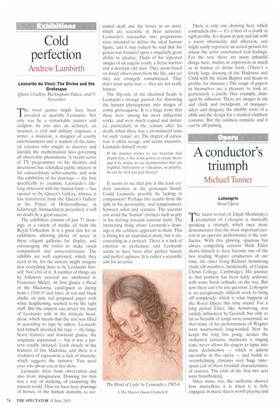Cold perfection
Andrew Lambirth
Leonardo da Vinci: The Divine and the Grotesque
Queen's Gallery, Buckingham Palace, until 9 November rr he word genius might have been I invented to describe Leonardo. Not only was he a remarkable painter and sculptor, he was also an architect, an inventor, a civil and military engineer, a writer, a musician, a designer of courtly entertainments and a student of the natural sciences who sought to discover and identify the mathematical laws governing all observable phenomena. A recent series of TV programmes on his theories and inventions has rekindled public interest in his extraordinary achievements, and now this exhibition of his drawings — the first specifically to examine Leonardo's lifelong obsession with the human form — has opened in the Queen's Gallery, whence it has transferred from the Queen's Gallery at the Palace of Holyroodhouse, in Edinburgh. Immaculately presented, it will no doubt be a great success.
The exhibition consists of just 77 drawings, in a variety of media, all from the Royal Collection. It is a good size for an exhibition, allowing plenty of space in these elegant galleries for display, and encouraging the visitor to make visual comparisons and cross-references. The exhibits are well captioned, which they need to be, for the unwary might imagine that everything here is by Leonardo himself. Not a bit of it. A number of things are by followers (several are attributed to Francesco Melzi), At first glance a Head of the Madonna, catalogued as dating from c.1510-15 and later, in red and black chalks on pale red prepared paper with white heightening, seemed to be the right stuff. But the experts can detect the hand of Leonardo only in the intricate headdress, which means that the rest was filled in according to type by others. Leonardo had himself invented the type — the large, heavy features and downcast glance, the enigmatic expression — but it was a pattern readily imitated. Look closely at the features of this Madonna, and there is a weakness of expression, a lack of intensity, which suggests the imitator. You need your wits about you in this show.
Leonardo drew from observation and also from imagination. Drawing for him was a way of studying, of examining the natural world. Thus we have here drawings of horses, of the human anatomy (a sec
tioned skull and the bones in an arm), which are scientific in their accuracy. Leonardo's researches into proportions were intended to define the ideal human figure, and it may indeed be said that his genius was founded upon a singularly great ability to idealise. Think of his repeated images of an angelic youth, a fierce warrior and a decrepit old man. They seem based on direct observation from the life, and yet they are strangely romanticised. They don't seem quite true — they are not really human.
The flip-side of the idealised heads is Leonardo's strange passion for distorting the human physiognomy into images of comic grotesquerie. It is a huge irony that these were among his most influential works, and were much copied and imitated, particularly in the century after his death, when there was a pronounced taste for such 'comic' art. The degree of caricature is often savage, and seems excessive. Leonardo himself wrote:
If the painter wishes to see beauties that charm him, it lies in his power to create them; and if he wishes to see monstrosities that are frightful, buffoonish or ridiculous, or pitiable, he can be lord and god thereof.
It seems to me that pity is the least evident emotion in the grotesque heads. Could Leonardo possibly be lacking in compassion? Perhaps this results from the split in his personality, and temperament, between artist and scientist. The scientist can avoid the 'human' instincts such as pity in his striving towards rational truth. The interesting thing about Leonardo's drawings is the coldness apparent in them. This is fitting for an anatomical study, but is disconcerting in a portrait. There is a lack of emotion in perfection. and Leonardo seems to have been after perfect beauty and perfect ugliness. It is rather a scientific aim for an artist. There is only one drawing here which contradicts this — it's a bust of a youth in right profile. It's drawn in pen and ink with a warm informality and affection, and might easily represent an actual person for whom the artist entertained real feelings. For the rest, there are many splendid things here, studies in expression as much as in human or divine form, (There's a lovely large drawing of the Madonna and Child with the infant Baptist and heads in profile, for instance.) The range of papers in themselves are a pleasure to look at, particularly a patchy blue example, damaged by adhesion. There are images in ink and chalk and metalpoint, of masqueraders and dragons, the chubby torso of a child and the design for a musical elephant costume. But the coldness remains, and it can be off-putting.


































































































 Previous page
Previous page